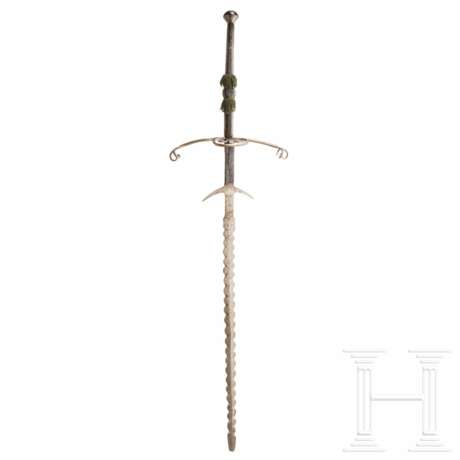ID 1324864
Lot 6374 | Großer Bidenhänder, deutsch/ Schweiz, um 1580
Geflammte Klinge mit rhombischem Querschnitt. Lange Fehlschärfe mit zwei seitlichen Parierhaken und originaler Belederung. Weit ausladende gegratete Parierstange, die Enden jeweils in drei Haken auslaufend. Beidseitig große gegratete Parierringe mit eingesteckten Lilienmotiven. Originale lederbezogene Hilze mit Fransenaufputz. Doppelt konischer Knauf, auf der Oberseite plastisch geschnittene Blüte. Länge 185 cm.
Provenienz: Sammlung Dr. Heinrich Tanner in Herisau (Schweiz). Abgebildet in: Flammberg-Schwerter, Katalog der Sonderausstellung in der Festung Heldsberg, St. Margrethen, Herisau 2005, S. 25. Erworben bei Stuker in Bern, Dezember 1974, ehemals Sammlung Conan Doyle, Schloss Lucens.
A large Swiss or German two-handed sword, circa 1580
A large Swiss or German two-handed sword, circa 1580
Undulating blade of flattened diamond section. The long ricasso with two lateral guards and the original leather cover. Extended, ridged quillons, the ends both extending into three hooks. The large, ridged guard rings entwined around stylised fleur-de-lys motifs on both sides. The original, leather-covered grip with a decorative fringe. Double tapered pommel, a three-dimensional flower chiselled on the top. Length 185 cm.
Provenance: Collection of Dr. Heinrich Tanner in Herisau (Switzerland). Illustrated in: Flammberg-Schwerter, Katalog der Sonderausstellung in der Festung Heldsberg, St. Margrethen, Herisau 2005, p. 25. Acquired from Stuker in Berne, December 1974, formerly in the Conan Doyle Collection, Lucens Castle.
Condition: II
| Auction house category: | Swords, Epees and Rapiers |
|---|
| Auction house category: | Swords, Epees and Rapiers |
|---|
| Address of auction |
Hermann Historica Bretonischer Ring 3 85630 Grasbrunn / München Germany | ||||||||||||||
|---|---|---|---|---|---|---|---|---|---|---|---|---|---|---|---|
| Preview | |||||||||||||||
| Phone | +49 (0)89 5472 649 0 | ||||||||||||||
| Fax | +49 (0)89 5472 64999 | ||||||||||||||
| Buyer Premium | 25 % | ||||||||||||||
| Conditions of purchase | Conditions of purchase | ||||||||||||||
| Business hours | Business hours
|



